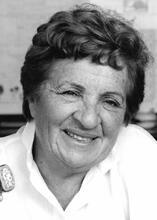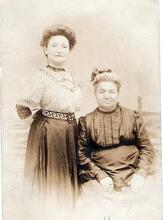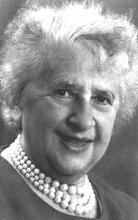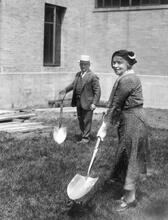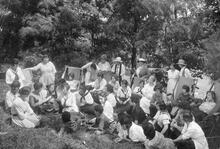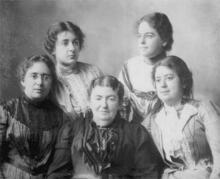Elma Ehrlich Levinger
Elma Ehrlich Levinger helped strengthen the Jewish community through her leadership of Jewish women’s organizations, but her books for children and adults may have had an even greater impact on American Jews. Levinger taught in rural schools in Iowa and Illinois for two years before studying English and drama at the University of Chicago and Radcliffe College. After her marriage to Rabbi Lee Levinger in 1916, she turned to editing the magazine Jewish Child. She also began writing books to instill pride in Jewish children, such as 1923’s In Many Lands, which described different Jewish traditions throughout the diaspora, and Fighting Angel, her 1946 biography of Henrietta Szold. Beyond her writing, Levinger remained active in the Jewish community throughout her life.
Article
Active in an array of Jewish women’s and youth organizations, Elma Ehrlich Levinger was also the author of over thirty books for children and several for adults—all of which emphasize the importance of maintaining Jewish identity in America. Levinger used both drama and the short story as a means of educating young people and women about Jewish history and traditions, hoping to encourage them to participate in Jewish social life.
Elma Ehrlich Levinger was born on October 6, 1887, in Chicago to Samuel and Sarah (Fernberg) Ehrlich. At age eighteen, she became a teacher in rural schools in Iowa and Illinois for two years. After attending the University of Chicago (1907–1908) and Radcliffe College (1911–1912), where she studied English and drama, she gradually extended her talents as a teacher to Jewish education. Combining the arts and community service, she worked as the director of a junior drama league in Chicago in 1912, and as director of entertainment for the Bureau of Jewish Education in New York City (1913–1915). On June 15, 1916, she married Lee J. Levinger, who later became a rabbi at the Veterans Administration Hospital in Menlo Park, California. The couple had three children, Samuel Harold, Leah Judith, and Joseph Solomon.
Sharing a belief in the importance of Jewish education for American youth, the Levingers worked collaboratively on a book entitled The Story of the Jew for Young People (1929). Through her books and as editor of the magazine Jewish Child, Levinger actively sought to build a strong cultural identity among Jewish youth in the process of American assimilation. Her series of tales, In Many Lands (1923), emphasizes the role of different traditions in connecting Jews throughout the Lit. (Greek) "dispersion." The Jewish community, and its areas of residence, outside Erez Israel.diaspora. In her book Great Jewish Women (1940) and her biography of Henrietta Szold called Fighting Angel (1946), she highlights the importance of women’s contributions to Jewish life.
Combining her roles of community leader and writer, Levinger also attempted to cultivate Jewish identity among middle-class women. The Tower of David (1924), published for the National Council of Jewish Women, is a collection of stories that served a social purpose, especially for Jewish women’s organizations. Underscoring the ability of the short story to “amuse, inspire, and instruct,” the book offers suggestions on how to plan programs accessible to a variety of women.
A member of the National Council of Jewish Women’s National Committee on Religion, the National Council for Prevention of War, the Birth Control League, and Hadassah, Levinger was a vocal participant within the Jewish community, as well as a prolific writer.
Elma Ehrlich Levinger died suddenly on January 28, 1958, in Hawaii, while traveling to her home in Los Altos, California, after a three-month vacation in the South Pacific.
SELECTED WORKS BY ELMA EHRLICH LEVINGER
The Burden: A Play in One Act (1918).
A Child of the Frontier: A One-Act Play About Abraham Lincoln (1925).
Fighting Angel: The Story of Henrietta Szold (1946).
Grapes of Canaan: A Novel (1931).
Great Jewish Women (1940).
In Many Lands: Stories of How the Scattered Jews Kept Their Festivals (1923).
Jephthah’s Daughter: A Biblical Drama in One Act (1921).
Jewish Adventures in America (1954).
Jewish Holyday Stories: Modern Tales of the American Jewish Youth (1918).
More Stories of the New Land (1938).
The New Land: Stories of Jews Who Had a Part in the Making of Our Country (1920).
Pilgrims to Palestine and Other Stories (1940).
The Story of the Jew for Young People, with Rabbi Lee J. Levinger (1929).
The Tower of David: A Book of Stories for the Program of Women’s Organizations (1924).
AJYB 24:170.
“Author Elma Levinger Dies in Hawaii.” San Francisco Chronicle, January 29, 1958, 35.
EJ, s.v. “Levinger, Lee J.”.
“Mrs. Lee Levinger Dies.” NYTimes, January 31, 1958, 21:1.
UJE; Who’s Who in America. Vol. 30, 1958–1959 (1958): 1652.
WWIAJ (1926, 1928, 1938).
WWWIA 3.


